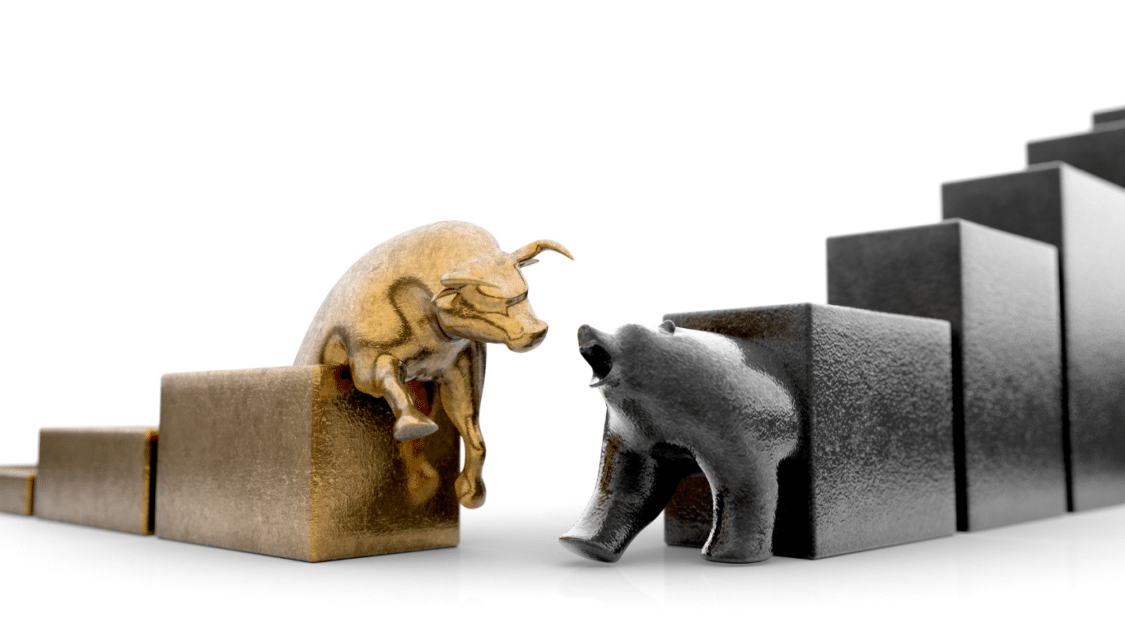Double Top and Double Bottom patterns are two of the most commonly observed technical analysis tools used by traders in the stock market. These patterns provide valuable insights into an asset’s trend reversal and price movement, making them an essential aspect of any successful trading strategy.

What is a double top?
A double top is a bearish reversal pattern appearing on a chart after an uptrend. It is named as such because it resembles the letter “M” or “W.” It is considered a bearish reversal pattern because it signals a potential trend reversal from an uptrend to a downtrend.
The pattern is formed when the price of an asset reaches a high point, retraces, and then reaches the same high point again before moving down. This creates two peaks at approximately the same price level, hence the name “double top”.
The build of a double-top pattern is a sign of waning bullish momentum. As the price fails to reach new highs, it indicates that the buying pressure that was driving the uptrend has weakened, and that the sellers are now in control. The double top pattern is usually confirmed when the price breaks below a support level, often referred to as the “neckline.”
Traders often use double tops as an opportunity to enter short positions, betting on a price decrease. However, it is important to note that the pattern is not always a guarantee of a trend reversal, and traders should consider additional technical and fundamental analysis before making a trade decision.
Is double top bearish or bullish?
In technical analysis, a double top is regarded as a bearish reversal pattern. It suggests a probable trend reversal from an uptrend to a downtrend, indicating that the upswing’s driving force—the buyers—has weakened, and the selling is now in charge.

What is double bottom?
Double bottom is a bullish reversal pattern appearing on a chart after a downtrend. It is named as such because it resembles the letter “V”. This pattern signals a potential trend reversal from a downtrend to an uptrend.
The pattern is formed when the price of an asset reaches a low point, retraces, and then reaches the same low point again before moving up. This creates two troughs at approximately the same price level, hence the name “double bottom”.
The formation of a double-bottom pattern indicates that the selling pressure that was driving the downtrend has weakened and that the buyers are now in control. The double bottom pattern is usually confirmed when the price breaks above a resistance level, often referred to as the “neckline.”
Traders often use double bottoms as an opportunity to enter long positions, betting on a price increase. However, note that the pattern is not always a guarantee of a trend reversal, and traders should consider additional technical and fundamental analysis before making a trade decision.
Is double bottom bearish or bullish?
In technical analysis, a double bottom is regarded as a bullish reversal pattern. The possible trend reversal from a downtrend to an uptrend. Meaning that the selling pressure that was driving the decline has subsided and the buyers are now in charge.
Trading with Double Top: A Step-by-Step Guide
- Identify the pattern: Look for a chart with a clear uptrend and two peaks at approximately the same price level.
- Determine the neckline: Draw a horizontal line connecting the lows between the two peaks. This line represents the support level or the neckline.
- Wait for confirmation: Wait for the price to break below the neckline. This confirms the formation of a double top pattern and signals a potential trend reversal.
- Enter a short position: Once the price breaks below the neckline, enter a short position, betting on a price decrease.
- Set a stop loss: To limit future losses, set a stop loss order above the neckline.
- Take profit: Consider taking profits when the price reaches the next support level or when a new bearish pattern forms.
It is important to note that the double top pattern is not always a guarantee of a trend reversal, and traders should consider additional technical and fundamental analysis before making a trade decision. This can include examining chart patterns, analyzing market sentiment, and monitoring economic indicators.
Trading with Double Bottom: A Step-by-Step Guide
- Identify the pattern: Look for a chart with a clear downtrend and two troughs at approximately the same price level.
- Determine the neckline: Draw a horizontal line connecting the highs between the two troughs. This line represents the resistance level or the neckline.
- Wait for confirmation: Wait for the price to break above the neckline. This confirms the formation of a double bottom pattern and signals a potential trend reversal.
- Enter a long position: Once the price breaks above the neckline, enter a long position, betting on a price increase.
- Set a stop loss: To limit potential losses, set a stop loss order below the neckline.
- Take profit: Consider taking profits when the price reaches the next resistance level or when a new bullish pattern forms.
It is important to note that the double bottom pattern is not always a guarantee of a trend reversal, and traders should consider additional technical and fundamental analysis before making a trade decision. This can include examining chart patterns, analyzing market sentiment, and monitoring economic indicators.

Closing Thoughts:
In conclusion, double tops and double bottoms are important technical analysis tools that can provide valuable insights into the potential trend reversal and price movement of an asset. Understanding the formation and confirmation of these patterns, as well as the key elements, strategies, and tools associated with them, is essential for traders who want to make informed decisions and achieve profitable outcomes. However, it’s important to remember that these patterns are not always a guarantee of a trend reversal, and traders should consider additional technical and fundamental analysis before making a trade decision. Nevertheless, incorporating double tops and double bottoms into your trading strategy can be a valuable addition to your overall investment approach.
What you need to know about the Fundamental Analysis of Stocks:

